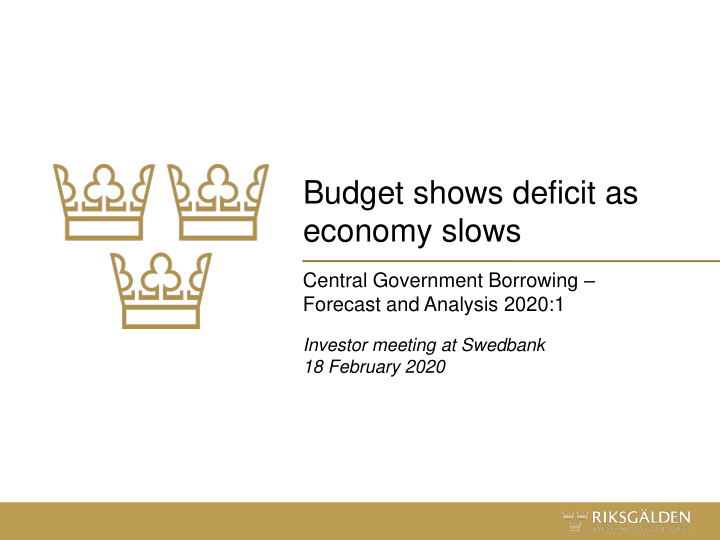



Budget shows deficit as economy slows Central Government Borrowing – Forecast and Analysis 2020:1 Investor meeting at Swedbank 18 February 2020
Swedish economy continues to grow slowly Budget deficit for both 2020 and 2021 Plan for increased bond borrowing unchanged
Stabilisation since last time but also a new risk • Stabilisation and turnaround in Purchasing Managers' Index, manufacturing global economy during the autumn Index 65 • Swedish developments also in line 60 with previous forecast 55 • New risk: the corona virus 50 45 40 2017 2018 2019 2020 USA Euro area Germany United Kingdom Sweden Sources: ISM, Markit and Swedbank
Lower volatility in GDP growth The Great Moderation – back again after the financial crisis GDP volatility in the G7 countries Standard deviations 4 3 2 1 0 1975 1980 1985 1990 1995 2000 2005 2010 2015 Note: Volatility is a five-year rolling standard deviation of an unweighted average of the countries’ GDP growth, measured as yearly percentage change Sources: OECD Economic Outlook and Debt Office
Swedish economy continues to grow slowly GDP growth • Weak growth on the whole, Yearly percentage change some recovery next year 3 • Unemployment to rise as the 2 business cycle weakens 1 • Small revisions to forecasts 0 2017 2018 2019 2020 2021 This forecast Previous forecast Sources: Statistics Sweden and the Debt Office
Withdrawals from tax accounts also weigh on budget Expected net outflow of SEK 10 billion in 2020 and SEK 15 billion in 2021 Amount in tax accounts SEK billion 90 80 70 60 50 40 30 20 10 0 2013 2014 2015 2016 2017 2018 2019 2020 Companies Private individuals Note: 12-month moving average Source: The Swedish Tax Agency and the Debt Office
Budget deficit both this year and next Central government budget balance • Weaker business cycle makes a SEK billion mark, but the turnaround is 120 reinforced by temporary factors 100 80 • Somewhat smaller deficit 60 compared with previous forecast 40 20 • Capital investments in tax 0 accounts add to uncertainty -20 -40 2017 2018 2019 2020 2021 Outcome This forecast Previous forecast
Debt Office acts within a given framework Central government Objective to funding requirement minimize long-term (budget deficit cost of debt and + redemptions) consider risks Government Debt Office guidelines for debt strategies and borrowing policy management
Higher borrowing requirement after four-year decline SEK billion 600 450 300 150 0 -150 2014 2015 2016 2017 2018 2019 2020 2021 Net borrowing req. Redemptions Other Total borrowing req. Source: the Debt Office
New forecast causes no change in issuance plan Issuance volume of nominal bonds to increase gradually SEK billion 300 200 100 0 2014 2015 2016 2017 2018 2019 2020 2021 Nominal government bonds Inflation-linked bonds T-bills Foreign Currency Bonds exkl. lån för Riksbanken Source: The Debt Office Note: Excludes on-lending to the Riksbank
Green bond to complement regular issuance • One issue in 2020 1. Evaluation and selection • Proceeds linked to defined of expenditures green budget expenditures • Preparations under way – framework, selection of 2. Issuance expenditures etc. • Selection of green expenditures sets scope for size of issuance 3. Reporting • Volume shall also be compliant with the objective for central Process for green bond government debt management
Temporary increase in T-bills to meet redemptions Balance in liquidity management, SEK billion 75 50 25 0 -25 -50 -75 -100 -125 -150 2016 2017 2018 2019 2020 2021 2022 Monthly cash balance Yearly average
Lowest debt as share of GDP since the 1970s SEK billion Per cent of GDP 2 000 100 1 800 90 1 600 80 1 400 70 1 200 60 1 000 50 800 40 600 30 400 20 200 10 0 0 Central govt. debt Maastricht debt Central govt. debt, % Maastricht debt, % Source: The Debt Office and Statistics Sweden
Strained liquidity in the government bond market Assessment of market liquidity Turnover ratio, nominal government bonds Grade Turnover ratio Fraction 5 5% 100% 4% 80% 4 3% 60% 3 2% 40% 2 1% 20% 1 0% 0% 2012 2014 2016 2018 2020 Riksbank's holdings (RA) Domestic investors Turnover ratio (LA) Interantional investors Primary dealers Ratio excl. Riksbank's holdings (LA) Average daily turnover over the past 60 trading days in relation Assessment of liquidity in terms of volume, grades from 1 to 5 to the average outstanding stock during that period. Source: Kantar Sifo Prospera Source: Riksbank, the Debt Office
New conditions for debt management • Surplus target and low level of central government debt • Regulations affecting the fixed-income market • Effects of low-rate environment and QE • Sustainability aspects • Tax account being used for capital investments
The new world is already having an effect • Necessary to prioritize between funding instruments • Issuance volumes reached a minimum level in 2018 • Outright auctions instead of switches when introducing a new bond • Green bond in 2020 • Need for flexibility within liquidity management In- or outflows from tax accounts Variation in repo volumes Longer periods of cash surplus
Recommend
More recommend